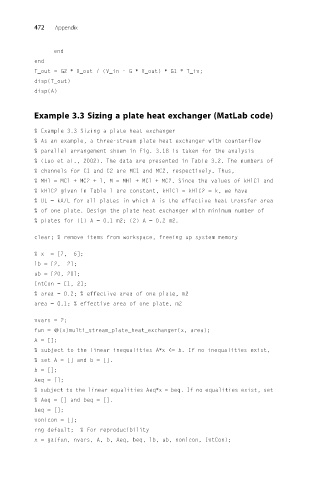Page 489 - Design and Operation of Heat Exchangers and their Networks
P. 489
472 Appendix
end
end
T_out = G2 ∗ V_out / (V_in - G ∗ V_out) ∗ G1 ∗ T_in;
disp(T_out)
disp(A)
Example 3.3 Sizing a plate heat exchanger (MatLab code)
% Example 3.3 Sizing a plate heat exchanger
% As an example, a three-stream plate heat exchanger with counterflow
% parallel arrangement shown in Fig. 3.18 is taken for the analysis
% (Luo et al., 2002). The data are presented in Table 3.2. The numbers of
% channels for C1 and C2 are MC1 and MC2, respectively. Thus,
% MH1 = MC1 + MC2 + 1, M = MH1 + MC1 + MC2. Since the values of kH1C1 and
% kH1C2 given in Table 1 are constant, kH1C1 = kH1C2 = k, we have
% UL = kA/L for all plates in which A is the effective heat transfer area
% of one plate. Design the plate heat exchanger with minimum number of
% plates for (1) A = 0.1 m2; (2) A = 0.2 m2.
clear; % remove items from workspace, freeing up system memory
% x = [7, 6];
lb = [2, 2];
ub = [20, 20];
IntCon = [1, 2];
% area = 0.2; % effective area of one plate, m2
area = 0.1; % effective area of one plate, m2
nvars = 2;
fun = @(x)multi_stream_plate_heat_exchanger(x, area);
A = [];
% subject to the linear inequalities A∗x <= b. If no inequalities exist,
% set A = [] and b = [].
b = [];
Aeq = [];
% subject to the linear equalities Aeq∗x = beq. If no equalities exist, set
% Aeq = [] and beq = [].
beq = [];
nonlcon = [];
rng default; % For reproducibility
x = ga(fun, nvars, A, b, Aeq, beq, lb, ub, nonlcon, IntCon);

